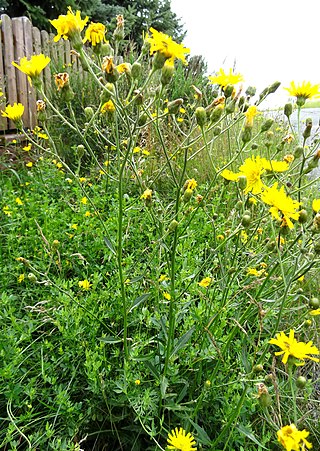
Acer laevigatum, the smooth maple or Nepal maple, is an atypical species of maple native to southern China, northern India, northern Myanmar, Nepal, and northern Vietnam. It grows at moderate altitudes of 1,000-2,000 m, with a wet monsoon climate.

Lake Ranco is situated in the Ranco Province of Los Lagos Region in Chile. Covering an area of 442 km2, it is the largest lake in the Los Ríos Region and the fourth largest in Chile. It has approximately 25 islands and islets, but only 4 are currently inhabited.

Leptospermum laevigatum, commonly known as the coast tea tree, is a species of shrub or small tree that is endemic to south-eastern Australia, but has been widely introduced in other places where it is often considered to be a weed. It has thin, rough bark on the older stems, narrow egg-shaped leaves, relatively large white flowers and flat topped fruit that is shed shortly after reaching maturity.

Hieracium laevigatum, or smooth hawkweed, is a Eurasian plant species in the tribe Cichorieae within the family Asteraceae. It is widespread across much of Europe and western Asia. It is very similar to Hieracium sabaudum and can be found on dry, more or less nutrient rich soil in light woods, grassy embankments and fields, or on walls.

Equisetum laevigatum is a species of horsetail in the family Equisetaceae. It is known by the common names smooth horsetail and smooth scouring rush. This plant is native to much of North America except for northern Canada and southern Mexico. It is usually found in moist areas in sandy and gravelly substrates. It may be annual or perennial. It grows narrow green stems sometimes reaching heights exceeding 1.5 meters. The leaves at the nodes are small, scale-like brownish sheaths and there are occasionally small, spindly branches. The stems are topped with rounded cone-shaped sporangia.

Homalopoma, common name the dwarf turbans, is a genus of mostly very small sea snails with a calcareous operculum, marine gastropoda molluscs in the subfamily Colloniinae of the family Colloniidae.
The Angachilla River is a river of Chile. The river and the wetland of the same name drains toward Valdivia River to which it connects near San Ramón Peninsula. The southern peripheral neighborhoods of Valdivia reaches the revier.

The Claro River is a river of Chile located in the Maule Region. It rises in the Andes, in the Radal Siete Tazas National Park and flows northwest until the city of Molina. Then, it flows southwest, crosses below the Panamericana, to the vicinity of the city of Talca to empty into the Maule River. In this last portion of its course, the river receives the waters of the tributary Lircay River.
The Pichoy River is a river of Chile. The invasive plant species Limnobium laevigatum is present in the river.
Sinum laevigatum is a species of predatory sea snail, a marine gastropod mollusk in the family Naticidae, the moon snails.
Carenum is a genus of beetles in the family Carabidae, containing the following species:

Limnobium laevigatum is a floating aquatic plant, and is a member of the family Hydrocharitaceae. Common names include West Indian spongeplant, South American spongeplant and Amazon or smooth frogbit. This plant was introduced to North American waterways through use in aquariums and aquascapes.
Carenum affine is a species of ground beetle in the subfamily Scaritinae. It was described by William John Macleay in 1864.
Carenum anthracinum is a species of ground beetle in the subfamily Scaritinae, found in Australia. It was described by William John Macleay in 1864.
Carenum coruscum is a species of ground beetle in the subfamily Scaritinae, found in Australia. It was described by William John Macleay in 1864.
Carenum distinctum is a species of ground beetle in the subfamily Scaritinae, found in Australia. It was described by William John Macleay in 1864.
Carenum elegans is a species of ground beetle in the subfamily Scaritinae, tribe Scaritini and subtribe Carenina. It was described by William John Macleay in 1864 from Port Denison, Western Australia.
Carenum puncticolle is a species of ground beetle in the subfamily Scaritinae, found in Australia. It was described by William John Macleay in 1864.
Carenum rectangulare is a species of ground beetle in the subfamily Scaritinae, found in Australia. It was described by William John Macleay in 1864.
Carenum violaceum is a species of ground beetle in the subfamily Scaritinae, found in Australia. It was described by William John Macleay in 1864.







